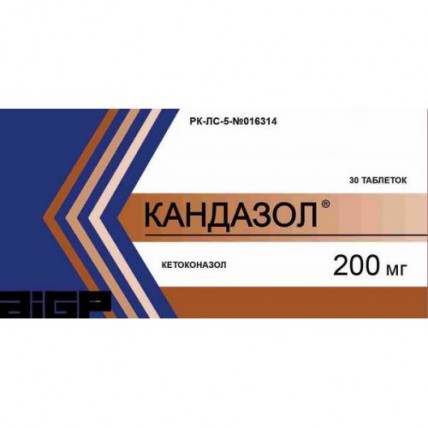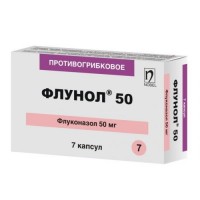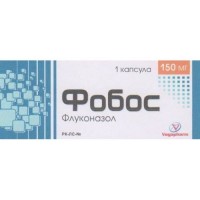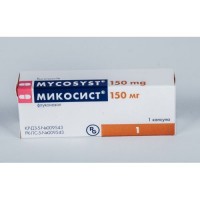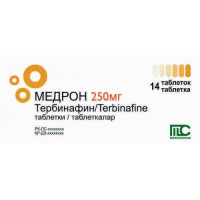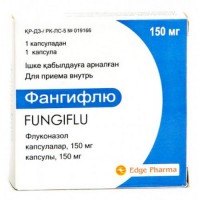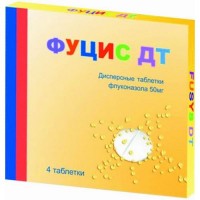Kandazol 200 mg (30 tablets)
- $24.60
Out Of Stock
The instruction for medical use of medicine This medicine is subject to additional monitoring. It will allow to reveal new information on safety quickly. We appeal to health care providers to report about any suspected undesirable reactions. КАНДАЗОЛ® the Trade name of Kandazol® the International unlicensed name Ketokonazol Lekarstvennaya a form of the Tablet of 200 mg Structure One tablet contains active agent: ketokonazol 200 mg, excipients: potato starch, lactoses monohydrate, hydroxypropyl cellulose, magnesium or calcium stearate, calcium carboxymethylcellulose the Description of the Tablet of color, white with a creamy shade, round, with a biconvex surface Pharmacotherapeutic group Antifungal drugs for system use. Imidazole derivatives. Ketokonazol. The ATX J02A B02 code the Pharmacological Ketokonazol Pharmacokinetics Absorption properties represents weak bibasic substance which is dissolved and absorbed in acidic environment. The maximum concentration of a ketokonazol in blood plasma about 3.5 mkg/ml is reached in 1-2 hours after single oral administration of 200 mg of drug at meal time. The bioavailability at oral administration of drug is maximum at reception of tablets at meal time. Absorption of a ketokonazol is lower at patients with the lowered acidity of a stomach, for example, at persons who accept the medicines known as antacids (for example, aluminum a hydrochloride) and the drugs suppressing formation of gastric juice (for example, blockers of H2 of histamine receptors, inhibitors of a proton pomp) or at persons with the achlorhydria connected with certain diseases. Absorption of a ketokonazol at its use on an empty stomach for these persons increases at reception of a ketokonazol with acid drinks (such as not dietary Coca). If use of drug was preceded by use of omeprazolum, inhibitor of a proton pomp, the bioavailability of a ketokonazol at its reception on an empty stomach in a dose of 200 mg decreased to 17% of bioavailability at use of one ketokonazol. If use of drug was preceded by omeprazolum use, but the drug was taken with not dietary Coca, the bioavailability was 65% of bioavailability at use of one ketokonazol. Distribution Linking with proteins of blood plasma, mainly with albumin fraction, makes 99%. Ketokonazol is widely distributed on fabrics, however only an insignificant part of drug gets into cerebrospinal fluid. Metabolism After absorption from digestive tract ketokonazol is metabolized in a liver with formation of a large number of inactive metabolites. It was shown that CYP3A4 is the main enzyme which participates in metabolism of a ketokonazol. Highways of metabolism are oxidation and splitting of imidazolny and piperazinovy rings, oxidizing O-dealkylation and aromatic hydroxylation. Ketokonazol is not the inductor of own metabolism. Removal Removal from blood plasma is two-phase: within the first 10 hours the elimination half-life makes 2 hours, and in the subsequent – 8 hours. About 13% of a dose are removed with urine of which from 2 to 4% are made by not changed medicinal substance. Drug is emitted generally with bile in digestive tract, at the same time about 57% of drug are removed with a stake. Special groups of patients Patients with a liver or renal failure the Pharmacokinetics of a ketokonazol at patients with a liver or renal failure significantly did not differ from pharmacokinetics at healthy faces. Children of Data on pharmacokinetics at use of a ketokonazol in the form of tablets at children are limited. A pharmacodynamics Ketokonazol – synthetic derivative a dioxolane imidazole, possessing fungicide or mikostatichesky action against dermatophytes, yeast (Candida, Malassezia, Torulopsis, Cryptococcus), dimorphous mushrooms and the highest mushrooms (eumitset). Are less sensitive to action of a ketokonazol: Aspergillus spp., Sporothrix schenckii, some Dermatiaceae, Mucor spp. and other phycomycetes, except for Entomophthorales. Tablets of the drug Kandazol® are active concerning the infections caused by Blastomyces dermatitidis, Coccidioides immitis, Histoplasma capsulatum, Paracoccidioides brasiliensis. Ketokonazol inhibits biosynthesis of ergosterol in fungi and changes structure of other lipidic components in membranes. At administration of drug in a dose of 200 mg 2 times a day within 3-7 days can be observed small increase in an interval of QT: average maximum increase in an interval of QT up to 6-12 ms was observed 1-4 hours later after reception when concentration of a ketokonazol in blood plasma reached the maximum values. However such increase in an interval of QT is considered clinically not significant. Indications Ketokonazol is shown only for treatment of zhizneugrozhayushchy system (deep) mycoses: - zymonematosis, coccidioidomycosis, histoplasmosis, chromomycosis, parakoktsidiomikoz. Because of risk of hepatotoxicity, a tablet it is necessary to use only when the potential advantage outweighs potentially possible harm, also in view of existence of local dosage forms of a ketokonazol and other drugs. Кандазол® it is not necessary to apply in fungal meningitis as ketokonazol badly gets into cerebrospinal liquid. The route of administration and doses In system mycoses is appointed by the adult on 1 tablet once a day, in case of lack of effect the dose can be increased to 2 tablets a day within 10 days, the course of treatment can be continued more than 10 days only after assessment of the response to therapy and control of function of a liver. In case of the passed dose it is necessary to accept it as soon as possible as in an organism it is necessary to maintain constant amount of medicine. If before reception of the following dose according to the schedule there was a little time, it is necessary to accept only the same following dose, without doubling it. Special patients with other opportunities the Pediatrics Safety and efficiency of a ketokonazol for children was not younger than 12 years is established. Therefore what - or recommendations about a dosage for children cannot be younger than 12 years are given. The drug dosage for teenagers is more senior than 12 years same as well as for adults. Elderly patients Data on use of a ketokonazol for patients are more senior than 65 years are quite limited, however, special instructions on correction of a dose are not required to these patients. Patients with a renal failure. Along with the fact that research data are limited Ketokonazol's pharmacokinetics considerably does not differ for patients with a renal failure in comparison with healthy patients and no special correction of a dosage is required. Patients with a liver failure. Ketokonazol is contraindicated to patients with an acute or chronic liver failure. Side effects the Short description of a profile of safety the Most frequent side reactions are insufficiency of adrenal glands, nausea, vomiting, an abdominal pain, diarrhea, an itching, rash and increase in level of liver enzymes. The most serious side reaction is hepatotoxicity, originally as the acute hepatic toxicity, but also can lead to a cholestatic injury or the mixed toxicity form. Nuclear heating plant, ALT, gamma GT, bilirubin and alkaline phosphatase have to be controlled with frequent intervals of treatment time. Safety of a ketokonazol was estimated on the basis of information published in literature and use of a ketokonazol as antifungal treatment. The side reactions which are listed below are classified according to a class of a system of bodies. Frequency groups are defined according to the following symbols: very often (≥ 1/10), it is frequent (≥ 1/100 to & lt, 1/10), is not frequent (≥ 1/1000 to & lt, 1/100), is rare (≥ 1/10000 to & lt, 1/1000), is very rare (& lt, 1/10000), it is unknown: it cannot be estimated from the available data. Very often Diseases of a gepatobiliarny system: atypical results of researches of function of a liver. Researches: increase in enzymes of a liver. Often Endocrine disorders: insufficiency of adrenal glands. Gastrointestinal disorders: nausea, abdominal pain, vomiting, diarrhea. Diseases of skin and hypodermic cellulose: itching, rash. Not often from blood and lymphatic system: thrombocytopenia. From the immune system: allergic states, including an acute anaphylaxis, anaphylactoid reactions and anaphylactic reactions and a Quincke's edema. From nervous system: headache, dizziness, drowsiness. Diseases of skin and hypodermic cellulose: small tortoiseshell, alopecia. General disturbances and conditions of the site of putting drug: asthenia. Researches: reduction quantity of thrombocytes. Seldom Diseases of a gepatobiliarny system: a serious gepatoksichnost, including jaundice, hepatitis, liver necrosis, cirrhosis, a liver failure, including the cases demanding transplantation or leading to death. Very seldom General disturbances and conditions of the site of putting drug: feverish state. It is not known Mental disorders: insomnia, nervousness. Metabolism and disorders of food: intolerance of alcohol, lack of appetite, the increased appetite. From nervous system: increase in intracranial pressure (papilloedema, fontanel convex), paresthesias. Visual disturbances: photophobia. Disturbances from respiratory organs, a thorax and mediastinum: nasal bleeding. Gastrointestinal disorders: dyspepsia, a meteorism, discoloration of language, dryness in a mouth, a dysgeusia. Diseases of skin and hypodermic cellulose: photosensitivity, exudative erythema, dermatitis, erythema, xerodermia. Diseases of musculoskeletal and connective tissue: myalgia, arthralgia. From the reproductive system and a disease of a mammary gland: disturbance of a menstrual cycle, azoospermism, erectile dysfunction, gynecomastia. General disturbances and conditions of the site of putting drug: swell peripheral, a general malaise, inflows of heat. Researches: transitional decrease in concentration of testosterone. The description of separate side reactions Hepatotoxicity the Serious hepatic toxicity caused by treatment ketokonazoly arises seldom (1/15000). Intense hepatic damages originally had the nature of a cholestatic injury or the mixed toxicity form. Fatal cases were celebrated especially at treatment continuation, despite increase in activity of liver enzymes. Increase in enzymes of a liver (≤ 5N и>, 5N) 13.5% and ~ 2.5% of patients respectively were observed in ~, and arose generally within the first 6 months of treatment. Level of enzymes of a liver returns to norm within 2-12 weeks after a dose decline or cancellation of a ketokonazol. Hepatotoxicity does not seem depending on a dose. All potentially connected factors of hepatotoxicity, and abnormal levels of enzymes of a liver the treatments found before ketokonazoly, it is necessary to take into account before considering the possibility treatment ketokonazoly. Ketokonazol it is not necessary to apply when enzymes of a liver are increased, and more than twice exceed the upper bound of norm, or together with other hepatotoxic drugs. Monitoring of enzymes of a liver should be carried out once a week within the first month of treatment, and then monthly within 6 months. In case of detection of increase in enzymes of a liver which are 3 times less than the upper bound of norm it is necessary to carry out more stringent control of function of a liver, and the daily dose has to be reduced at least by 200 mg. In case of increase in level of enzymes of a liver is 3 times higher than the upper bound of norm, ketokonazol it is necessary to stop and renew immediately treatment does not follow, because of risk of serious hepatic toxicity. Adrenal insufficiency Insufficiency of adrenal glands can arise at patients during treatment ketokonazoly without corticosteroid replacement (only at the blocking mode) or if insufficient replacement of glucocorticoid therapy is made (for patients at the mode of blocking and replacement). Instructing of patients on signs and symptoms of a hypocorticoidism has to be traced and be carried out (for example, weakness, fatigue, lack of appetite, nausea, vomiting, hypotension, a hyperpotassemia, a hyponatremia, a hyperpotassemia or a hypoglycemia). Insufficiency of adrenal glands can be found during periodic clinical assessment and monitoring of plasma / serum or salivary kortizolovy levels. In case of insufficiency of adrenal glands, treatment ketokonazoly has to be temporarily stopped or the dose has to be reduced, and, if necessary, corticosteroids of replacement therapy are added. The pediatrics the Frequency of emergence of hepatotoxicity can be higher at teenagers, than at adults. Contraindications - hypersensitivity to a ketokonazol and/or to any antifungal medicine of an imidazole, or to any of excipients - acute or chronic diseases of a liver and/or if the level of enzymes of a liver is twice higher than the upper bound of norm - a lactose intolerance, congenital insufficiency of Lapp-lactase or disturbance of absorption of a glucose/galactose - pregnancy and the period of a lactation - children's age up to 12 years - the congenital or documentary acquired prolongation of QTc - the accompanying therapy by any of medicines which can interact and lead to potentially life-threatening side reactions, · CYP3A4 metabolizirovanny inhibitors of GMG-KoA-reduktazy (for example, simvastatin, atorvastatin and lovastatin) in connection with the increased risk of toxicity of skeletal muscles, including a rhabdomyolysis, · eplerenon, in connection with the increased risk of development of a hyperpotassemia and hypotonia · substances which can increase concentration in plasma and have the potential of extension of an interval of QT: methadone, Disopyramidum, quinidine, dronedaron, Pimozidum, sertindol, sakvinavir (sakvinavir / ритонавир 1000/100 mg two times), ranolazin, mizolastin, galofantrin, · dabigatran because of the increased risk of bleeding, · to triazoles, oral midazolam and to alprazola because of potential to extend and increase a sedation and respiratory depression, · ergot alkaloids (for example, dihydroergotamine, ergometrine (Ergonovinovy), ergotamine and methylergometrine (metilergonovin) in connection with the increased risk of development of an ergotism and other serious vasospastic side effects, · lurazidon, · kvetiapin in connection with the increased risk of toxicity, · telitromitsin and klaritromitsin at patients with a heavy renal failure because of the increased risk of hepatotoxicity and extension of an interval of QT, · felodipin, nisoldipin in connection with the increased risk of developing hypostasis and stagnant heart failure, · colchicine at patients with a renal failure because of the increased risk of development of heavy side reactions, · irinotekan in connection with change of metabolism of this medicine, · everolimus, sirolimus (also known as rapamitsin) in connection with increase in concentration in plasma of these medicines, · vardenafit at men 75 years in connection with the increased risk of development of side effects are more senior, · paritaprevir / омбитасвир (ritonavir) in connection with the increased risk of development of side reactions, · fezoterodin and solifenatsin at patients with a renal failure. Not the exhaustive list of components which can interact with ketokonazoly and lead the list given above to potentially life-threatening reactions. Medicinal interactions the Medicines influencing absorption of a ketokonazol. The medicines affecting acidity of gastric juice reduce absorption of a ketokonazol. Influence of other medicines on metabolism of a ketokonazol. Ketokonazol is generally metabolized by CYP3A4 cytochrome. The enzyme-inducing drugs, such as rifampicin, rifabutin, carbamazepine, an isoniazid, not Virapinum, Mitotanum and Phenytoinum can reduce bioavailability of a ketokonazol considerably. Use of a ketokonazol with powerful inductors of enzymes is not recommended. Strong CYP3A4 inhibitors (for example, antiviral, such as ritonavir, strengthened ritonaviry darunavir and strengthened ritonaviry fosamprenavir) can increase bioavailability of a ketokonazol, these drugs should be used with care at joint introduction with ketokonazoly and patients should watch closely signs and symptoms of adrenal insufficiency. Doses
of a ketokonazol it has to be corrected as appropriate. Influence of a ketokonazol on metabolism of other medicines - Ketokonazol is powerful CYP3A4 inhibitor and can inhibit metabolism of drugs which are metabolized by this enzyme. It can lead to increase and/or extension of their effect, including adverse actions. - Data indicate what ketokonazol is CYP1A2 inhibitor and slightly inhibits CYP 2A6 and 2E1. At clinically significant concentration inhibition of CYP2B6, 2C9/C8, 2S19 and 2D6 ketokonazoly are not excluded. - Ketokonazol can inhibit transfer of medicines by means of a P-glycoprotein that can lead to increase in concentration in plasma of these drugs. - Ketokonazol inhibits BCRP (Protein of resistance of a breast cancer). This inhibition shows that there is no risk of interaction of substrates with BCRP at the system level. However ketokonazol can be BCRP inhibitor at the intestinal level in clinically significant concentration. Considering fast absorption of a ketokonazol, consumption of BCRP substrates has to be postponed for 2 hours after reception of a ketokonazol. Table 1. Interaction and recommendations for combined use. Interaction between ketokonazoly and other medicines, are listed below in the table (increase is designated as '↑', decrease as '↓', without any changes, as '↔'). The extents of interaction provided below are not absolute values and can depend on a dose of a ketokonazol, i.e. many results are provided after use of a dose of a ketokonazol of 200 mg and stronger interaction can be expected at higher dose and/or shorter interval of dosing. The following list not the exhaustive list of interactions between ketokonazoly and other medicines. Medicine on the therapeutic Expected Effect area on a medicinal uroven of the Recommendation for combined use the Anesthetizing opioids the Potentsialnoye's Methadone ↑ in plasma of concentration of methadone Contraindicated in connection with the increased risk of development of serious effects from a cardiovascular system, including extension of an interval of QT and ventricular tachycardia like 'pirouette', or respiratory organs or oppression of central nervous system. Buprenorphine IV and sublingual Buprenorphine: AUC: ↑ Cmax is multiple: ↑1.7-multiply Careful control. The dose of buprenorphine has to be adjusted. Alfentanil, the Potentsialnoye's fentanyl ↑ in plasma of concentration of alfentanil and fentanyl Is recommended careful monitoring of side effects (respiratory depression, sedation). There can be a need to lower a dose of alfentanil and fentanyl. Oxycodone Were noted ↑ in plasma of concentration of oxycodone Careful control. The dose of oxycodone can be adjusted. The antiarrhytmic drugs Disopyramidum Dronedaron Potentsialnoye Quinidine ↑ in plasma of concentration of Disopyramidum and quinidine daily led Repeated doses of 200 mg of a ketokonazol to 17-fold increase in influence of a dronedaron Contraindicated because of risk of serious cardiovascular effects, including extension of an interval of QT. The Potentsialnoye's digoxin ↑ in plasma of concentration of digoxin Careful monitoring of levels of digoxin is recommended. Anticoagulants and antiagregant Rivaroksaban Rivaroksaban: AUC: ↑ Cmax is multiple: ↑1.7-multiply It is not recommended because of the increased risk of bleeding. Tsilostazol Tsilostazol: AUC: ↑ 2.2 multiply General pharmacological activity of a tsilostazol increases by 35% at joint introduction with ketokonazoly. Careful control Is recommended a dose of a tsilostazol of 50 mg twice a day in a combination with ketokonazoly. Warfarin and others coumarin - the similar drugs Potential ↑ in plasma of concentration of warfarin. Careful control. Monitoring INR (the international normalized relation) is recommended. Dabigatran Dabigatran: AUC: ↑ 2.6-Cmax is multiple: ↑2.5-It is multiply contraindicated because of the increased risk of bleeding. Apiksaban Apiksaban AUC: ↑ 2-Cmax is multiple: ↑1.6-multiply it is not recommended because of the increased risk of bleeding. Anticonvulsant Karbamazepin Potentsialnoye Phenytoinum ↑ in plasma of concentration of carbamazepine and Phenytoinum Potential ↓ in plasma of concentration of a ketokonazol, as expected. (Induction of CYP3A enzymes) it is not recommended. (See also 'effect of other medicines on metabolism of a ketokonazol'). Antidiabetic means Repaglinid Repaglinid: AUC: ↑ 1.2-Cmax is multiple: ↑ 1.2-multiply Careful control. Dose adjustment of a repaglinid can be required. Saksagliptin Saksagliptin: AUC: ↑ 2.5-Cmax is multiple: ↑ 1.6-the Careful control which is multiply Connected with reduction of the corresponding values for an active metabolite. Correction of a dose of Saksagliptin can be required. Tolbutamide Tolbutamide: AUC: ↑ 1.7-multiply Careful control. Correction of a dose of tolbutamide can be required. Antimicrobic Rifabutin Rifampitsin Potentsialnoye's Isoniazid ↑ in plasma of concentration of a rifabutin. Potential ↓ in plasma of concentration of a ketokonazol, as expected. (CYP3A4 enzyme induction) it is not recommended. (See also 'effect of other medicines on metabolism of a ketokonazol') Telitromitsin Klaritromitsin Telitromitsin: AUC: ↑ 2-Cmax is multiple: ↑1.5-multiply Potential ↑ in plasma of concentration of a klaritromitsin it is not recommended. It is contraindicated at patients with a heavy renal failure because of risk of prolongation of an interval of QT and serious hepatic side reactions. A praziquantel Were noted ↑ in plasma of concentration of a prazikvantel Careful control. Dose adjustment of a prazikvantel can be required. Protivomigrenevy drugs ergot Alkaloids, such as dihydroergotamine, ergometrine (ergonovin), ergotamine, methylergometrine (metilergonovin) Potential ↑ in plasma of concentration of an ergot Contraindicated in connection with the increased risk of development of an ergotism and other serious vasospastic side effects. Eletriptan Eletriptan: AUC: ↑ 5.9-Cmax is multiple: ↑ 2.7-multiply it is not recommended. Antineoplastic Sunitinib Dazatinib Lapatinib Nilotinib Erlotinib Dabrafenib Kabozantinib kabozantinib Sunitinib of AUC: ↑ 1.5-Cmax is multiple: ↑ 1.5-Lapatinib is multiple: AUC: ↑ 3.6-Nilotinib of AUC is multiple: ↑ 3.0-Erlotinib is multiple: AUC: ↑ 1.9-Cmax is multiple: ↑ 1.7-multiply Dazatinib of a koncentration of Dazatiniba were found in AUC Dabrafenib plasma: ↑ 1.7-Cmax is multiple: ↑ 1.3-Kabozantinib of AUC is multiple: ↑ 1.4-Cmax is multiple: ↔ It is not recommended in connection with risk of the increased influence of these drugs and prolongations of QT. Ibrutinib Ibrutinib: AUC: ↑ 24-Cmax is multiple: ↑ 29-multiply it is not recommended as it can increase toxicity ibrutinib connected. Krizotinib Krizotinib of AUC: ↑ 3.2-Cmax is multiple: ↑ 1.4-multiply it is not recommended because of risk of prolongation of an interval of QT and serious hepatic side reactions. Monitoring of QT prolongation at simultaneous use. Irinotekan Irinotekan: AUC: ↑ 2.1-multiply Contraindicated owing to change of metabolism of this medicine. Bortezomib Busulfan Dotsetaksel Imatinib Kabazitaksel of Bortezomib: AUC: ↑ 1.4-multiply Imatinib: AUC: ↑ 1.4-Cmax is multiple: ↑ 1.3-multiply ↑ concentration of a dotsetaksel were found in plasma Potential ↑ in plasma of concentration of a busulfan Kabazitaksel AUC: ↑ 1.3-multiply Careful control. Dose adjustment of each drug can be required. Paklitaksel Paklitaksel: No changes in concentration in plasma with a concentrate of a paklitaksel were observed. Researches were not conducted with the connected nanoparticles of albumine. Careful control. Dose adjustment of a paklitaksel can be required. Vincristinum, vinblastine (periwinkle alkaloids) of Potentsialnoye ↑ in concentration plasma periwinkle alkaloids. Careful control as it can lead to earlier beginning and/or strengthening of severity of side effects. Neuroleptics, anxiolytics and hypnotic drugs to Alprazolam Midazolam Triazoles oral AUC: ↑ Cmax was observed: ↑ it was observed It is contraindicated because of risk of potentially long or increased sedation and respiratory depression. Midazolam IV midazolam: AUC: ↑ 1.6-multiply Careful control. Correction of a dose midazolam IV can be required. Lurazidon Lurazidon: AUC: ↑ 9-Cmax is multiple: ↑ 6-it is multiply contraindicated in connection with the increased risk of development of side effects. Potentsialnoye's Pimozidum ↑ in plasma of concentration of Pimozidum. It is contraindicated because of risk of serious cardiovascular events, including extension of an interval of QT. Buspiron Potentsialnoye ↑ in plasma of concentration of a buspiron. Careful control. Correction of a dose of a buspiron can be required. Aripiprazol Aripiprazol AUC: ↑ 1.6-Cmax is multiple: ↑ 1.4-multiply Careful control. The dose of an aripiprazol has to be reduced approximately by a half of the appointed dose. Potentsialnoye's haloperidol ↑ in plasma of concentration of a haloperidol. It is not recommended because of the increased risk of prolongation of an interval of QT and extrapyramidal symptoms. There can be a need to reduce a haloperidol dose. Sertindol Potentsialnoye ↑ in plasma of concentration of a sertindol. It is contraindicated because of risk of prolongation of an interval of QT. Reboksetin Reboksetin: AUC: ↑ 1.5-multiply of both enantiomers is not recommended because of a narrow therapeutic profile of a reboksetin. Kvetiapin Kvetiapin: AUC: ↑ 6.2-Cmax is multiple: ↑ 3.4-multiply Contraindicated because of risk of increase in toxicity connected a kvetiapina. Risperidon Potentsialnoye ↑ AUK of a risperidon: Careful control. Dose adjustment of a risperidon can be required. Antiviral drugs Maravirok Maravirok: AUC: ↑ 5-Cmax is multiple: ↑ 3.4-multiply Careful control. The dose of a maravirok has to be reduced up to 150 mg twice a day. Sakvinavir (Sakvinavir/ritonavir 1000/100 mg dva raza) Sakvinavir: AUC: ↔ Cmax: ↔ Ketokonazol AUC: ↑ 2.7-Cmax is multiple: ↑ 1.5-multiply (to CYP3A4 enzyme inhibition ritonaviry) It is contraindicated because of risk of prolongation of an interval of QT. Indinavir Indinavir (600 mg three times a day): AUC = 0.8-is multiple Cmin: ↑ 1.3-multiply (Concerning an indinavir in pure form 800 mg three times a day) Careful control. The dose decline of an indinavir up to 600 mg has to be considered each 8 hours. NeVirapin Ketokonazol: AUC: ↓0.28-Cmax is multiple: ↓0.56-multiply Nevirapin: plasma levels: ↑1.15-1.28 - it is multiple in comparison with control in the anamnesis (enzyme induction CYP3A) & lt
to Develop
of a ketokonazol it has to be corrected as appropriate. Influence of a ketokonazol on metabolism of other medicines - Ketokonazol is powerful CYP3A4 inhibitor and can inhibit metabolism of drugs which are metabolized by this enzyme. It can lead to increase and/or extension of their effect, including adverse actions. - Data indicate what ketokonazol is CYP1A2 inhibitor and slightly inhibits CYP 2A6 and 2E1. At clinically significant concentration inhibition of CYP2B6, 2C9/C8, 2S19 and 2D6 ketokonazoly are not excluded. - Ketokonazol can inhibit transfer of medicines by means of a P-glycoprotein that can lead to increase in concentration in plasma of these drugs. - Ketokonazol inhibits BCRP (Protein of resistance of a breast cancer). This inhibition shows that there is no risk of interaction of substrates with BCRP at the system level. However ketokonazol can be BCRP inhibitor at the intestinal level in clinically significant concentration. Considering fast absorption of a ketokonazol, consumption of BCRP substrates has to be postponed for 2 hours after reception of a ketokonazol. Table 1. Interaction and recommendations for combined use. Interaction between ketokonazoly and other medicines, are listed below in the table (increase is designated as '↑', decrease as '↓', without any changes, as '↔'). The extents of interaction provided below are not absolute values and can depend on a dose of a ketokonazol, i.e. many results are provided after use of a dose of a ketokonazol of 200 mg and stronger interaction can be expected at higher dose and/or shorter interval of dosing. The following list not the exhaustive list of interactions between ketokonazoly and other medicines. Medicine on the therapeutic Expected Effect area on a medicinal uroven of the Recommendation for combined use the Anesthetizing opioids the Potentsialnoye's Methadone ↑ in plasma of concentration of methadone Contraindicated in connection with the increased risk of development of serious effects from a cardiovascular system, including extension of an interval of QT and ventricular tachycardia like 'pirouette', or respiratory organs or oppression of central nervous system. Buprenorphine IV and sublingual Buprenorphine: AUC: ↑ Cmax is multiple: ↑1.7-multiply Careful control. The dose of buprenorphine has to be adjusted. Alfentanil, the Potentsialnoye's fentanyl ↑ in plasma of concentration of alfentanil and fentanyl Is recommended careful monitoring of side effects (respiratory depression, sedation). There can be a need to lower a dose of alfentanil and fentanyl. Oxycodone Were noted ↑ in plasma of concentration of oxycodone Careful control. The dose of oxycodone can be adjusted. The antiarrhytmic drugs Disopyramidum Dronedaron Potentsialnoye Quinidine ↑ in plasma of concentration of Disopyramidum and quinidine daily led Repeated doses of 200 mg of a ketokonazol to 17-fold increase in influence of a dronedaron Contraindicated because of risk of serious cardiovascular effects, including extension of an interval of QT. The Potentsialnoye's digoxin ↑ in plasma of concentration of digoxin Careful monitoring of levels of digoxin is recommended. Anticoagulants and antiagregant Rivaroksaban Rivaroksaban: AUC: ↑ Cmax is multiple: ↑1.7-multiply It is not recommended because of the increased risk of bleeding. Tsilostazol Tsilostazol: AUC: ↑ 2.2 multiply General pharmacological activity of a tsilostazol increases by 35% at joint introduction with ketokonazoly. Careful control Is recommended a dose of a tsilostazol of 50 mg twice a day in a combination with ketokonazoly. Warfarin and others coumarin - the similar drugs Potential ↑ in plasma of concentration of warfarin. Careful control. Monitoring INR (the international normalized relation) is recommended. Dabigatran Dabigatran: AUC: ↑ 2.6-Cmax is multiple: ↑2.5-It is multiply contraindicated because of the increased risk of bleeding. Apiksaban Apiksaban AUC: ↑ 2-Cmax is multiple: ↑1.6-multiply it is not recommended because of the increased risk of bleeding. Anticonvulsant Karbamazepin Potentsialnoye Phenytoinum ↑ in plasma of concentration of carbamazepine and Phenytoinum Potential ↓ in plasma of concentration of a ketokonazol, as expected. (Induction of CYP3A enzymes) it is not recommended. (See also 'effect of other medicines on metabolism of a ketokonazol'). Antidiabetic means Repaglinid Repaglinid: AUC: ↑ 1.2-Cmax is multiple: ↑ 1.2-multiply Careful control. Dose adjustment of a repaglinid can be required. Saksagliptin Saksagliptin: AUC: ↑ 2.5-Cmax is multiple: ↑ 1.6-the Careful control which is multiply Connected with reduction of the corresponding values for an active metabolite. Correction of a dose of Saksagliptin can be required. Tolbutamide Tolbutamide: AUC: ↑ 1.7-multiply Careful control. Correction of a dose of tolbutamide can be required. Antimicrobic Rifabutin Rifampitsin Potentsialnoye's Isoniazid ↑ in plasma of concentration of a rifabutin. Potential ↓ in plasma of concentration of a ketokonazol, as expected. (CYP3A4 enzyme induction) it is not recommended. (See also 'effect of other medicines on metabolism of a ketokonazol') Telitromitsin Klaritromitsin Telitromitsin: AUC: ↑ 2-Cmax is multiple: ↑1.5-multiply Potential ↑ in plasma of concentration of a klaritromitsin it is not recommended. It is contraindicated at patients with a heavy renal failure because of risk of prolongation of an interval of QT and serious hepatic side reactions. A praziquantel Were noted ↑ in plasma of concentration of a prazikvantel Careful control. Dose adjustment of a prazikvantel can be required. Protivomigrenevy drugs ergot Alkaloids, such as dihydroergotamine, ergometrine (ergonovin), ergotamine, methylergometrine (metilergonovin) Potential ↑ in plasma of concentration of an ergot Contraindicated in connection with the increased risk of development of an ergotism and other serious vasospastic side effects. Eletriptan Eletriptan: AUC: ↑ 5.9-Cmax is multiple: ↑ 2.7-multiply it is not recommended. Antineoplastic Sunitinib Dazatinib Lapatinib Nilotinib Erlotinib Dabrafenib Kabozantinib kabozantinib Sunitinib of AUC: ↑ 1.5-Cmax is multiple: ↑ 1.5-Lapatinib is multiple: AUC: ↑ 3.6-Nilotinib of AUC is multiple: ↑ 3.0-Erlotinib is multiple: AUC: ↑ 1.9-Cmax is multiple: ↑ 1.7-multiply Dazatinib of a koncentration of Dazatiniba were found in AUC Dabrafenib plasma: ↑ 1.7-Cmax is multiple: ↑ 1.3-Kabozantinib of AUC is multiple: ↑ 1.4-Cmax is multiple: ↔ It is not recommended in connection with risk of the increased influence of these drugs and prolongations of QT. Ibrutinib Ibrutinib: AUC: ↑ 24-Cmax is multiple: ↑ 29-multiply it is not recommended as it can increase toxicity ibrutinib connected. Krizotinib Krizotinib of AUC: ↑ 3.2-Cmax is multiple: ↑ 1.4-multiply it is not recommended because of risk of prolongation of an interval of QT and serious hepatic side reactions. Monitoring of QT prolongation at simultaneous use. Irinotekan Irinotekan: AUC: ↑ 2.1-multiply Contraindicated owing to change of metabolism of this medicine. Bortezomib Busulfan Dotsetaksel Imatinib Kabazitaksel of Bortezomib: AUC: ↑ 1.4-multiply Imatinib: AUC: ↑ 1.4-Cmax is multiple: ↑ 1.3-multiply ↑ concentration of a dotsetaksel were found in plasma Potential ↑ in plasma of concentration of a busulfan Kabazitaksel AUC: ↑ 1.3-multiply Careful control. Dose adjustment of each drug can be required. Paklitaksel Paklitaksel: No changes in concentration in plasma with a concentrate of a paklitaksel were observed. Researches were not conducted with the connected nanoparticles of albumine. Careful control. Dose adjustment of a paklitaksel can be required. Vincristinum, vinblastine (periwinkle alkaloids) of Potentsialnoye ↑ in concentration plasma periwinkle alkaloids. Careful control as it can lead to earlier beginning and/or strengthening of severity of side effects. Neuroleptics, anxiolytics and hypnotic drugs to Alprazolam Midazolam Triazoles oral AUC: ↑ Cmax was observed: ↑ it was observed It is contraindicated because of risk of potentially long or increased sedation and respiratory depression. Midazolam IV midazolam: AUC: ↑ 1.6-multiply Careful control. Correction of a dose midazolam IV can be required. Lurazidon Lurazidon: AUC: ↑ 9-Cmax is multiple: ↑ 6-it is multiply contraindicated in connection with the increased risk of development of side effects. Potentsialnoye's Pimozidum ↑ in plasma of concentration of Pimozidum. It is contraindicated because of risk of serious cardiovascular events, including extension of an interval of QT. Buspiron Potentsialnoye ↑ in plasma of concentration of a buspiron. Careful control. Correction of a dose of a buspiron can be required. Aripiprazol Aripiprazol AUC: ↑ 1.6-Cmax is multiple: ↑ 1.4-multiply Careful control. The dose of an aripiprazol has to be reduced approximately by a half of the appointed dose. Potentsialnoye's haloperidol ↑ in plasma of concentration of a haloperidol. It is not recommended because of the increased risk of prolongation of an interval of QT and extrapyramidal symptoms. There can be a need to reduce a haloperidol dose. Sertindol Potentsialnoye ↑ in plasma of concentration of a sertindol. It is contraindicated because of risk of prolongation of an interval of QT. Reboksetin Reboksetin: AUC: ↑ 1.5-multiply of both enantiomers is not recommended because of a narrow therapeutic profile of a reboksetin. Kvetiapin Kvetiapin: AUC: ↑ 6.2-Cmax is multiple: ↑ 3.4-multiply Contraindicated because of risk of increase in toxicity connected a kvetiapina. Risperidon Potentsialnoye ↑ AUK of a risperidon: Careful control. Dose adjustment of a risperidon can be required. Antiviral drugs Maravirok Maravirok: AUC: ↑ 5-Cmax is multiple: ↑ 3.4-multiply Careful control. The dose of a maravirok has to be reduced up to 150 mg twice a day. Sakvinavir (Sakvinavir/ritonavir 1000/100 mg dva raza) Sakvinavir: AUC: ↔ Cmax: ↔ Ketokonazol AUC: ↑ 2.7-Cmax is multiple: ↑ 1.5-multiply (to CYP3A4 enzyme inhibition ritonaviry) It is contraindicated because of risk of prolongation of an interval of QT. Indinavir Indinavir (600 mg three times a day): AUC = 0.8-is multiple Cmin: ↑ 1.3-multiply (Concerning an indinavir in pure form 800 mg three times a day) Careful control. The dose decline of an indinavir up to 600 mg has to be considered each 8 hours. NeVirapin Ketokonazol: AUC: ↓0.28-Cmax is multiple: ↓0.56-multiply Nevirapin: plasma levels: ↑1.15-1.28 - it is multiple in comparison with control in the anamnesis (enzyme induction CYP3A) & lt
to Develop
